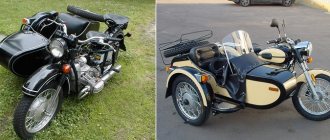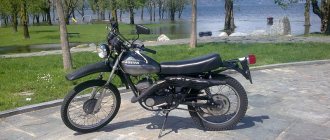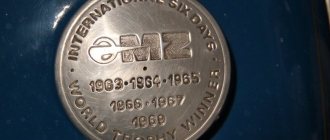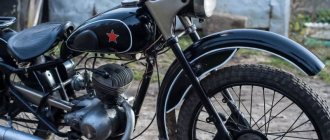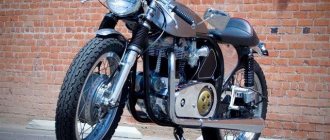001_MOTO_0710_052
No matter how difficult it is to admit, the Soviet “Dnepr” and “Ural”, on which several generations of motorcyclists grew up, are only derivatives of the legendary M-72 of the early 40s, and it, in turn, is an exact copy of the “Wehrmacht” BMW R71 model 1938. Why did our designers choose a model for the main combat and subsequently civilian motorcycle that the Germans themselves considered unpromising? Let’s try to figure it out, fortunately we have at hand an “object for research” - “era seventy-one”, just restored by the Krasnoyarsk restorer Mikhail Dmitrievich Shestakov (we talked about him and his works in “Moto”, No. 6-2009).
002_MOTO_0710_052
The discovery of this motorcycle is certainly a great success. It was produced only until 1941, and its circulation by Wehrmacht standards was extremely modest - no more than 3,500 copies. There are only a few “alive” left! Meanwhile, the German army’s quick abandonment of this model gave rise to a heap of legends about the reasons for the attention of Soviet engineers to it. According to the first version, the release of the M-72 in the USSR did not come as a surprise to the Germans: they allegedly guessed about its construction even before the start of mass production of their R71. The assumption, very similar to the myth, says that out of five BMWs sent for mountain tests to Switzerland, only three returned back. The other two disappeared without a trace - probably not without the help of the Soviet secret services. The second version is more prosaic. But it, which has a much greater chance of being true, is most likely a fiction. According to it, at a meeting of the Main Armored Directorate held in 1940, the issue of putting on the assembly line a simple and suitable motorcycle for our conditions, which could become the basis of motorized cavalry units, was considered. Representatives of domestic factories, in addition to imported equipment, naturally brought their own products. But both the TIZ-AM-600 and the PMZ A-750 - the only heavy motorcycles in the USSR at that time - were not domestic developments.
Moving in my posts from relatively simple motorcycle equipment to more complex ones, today I would like to present my last project, a 1939 BMW R71 motorcycle. This is perhaps one of the most recognizable German motorcycles of the first half of the last century, and at the same time it is the most counterfeited of all the motorcycles from the Second World War... Collectors say that today there are more of these models on the roads in Germany alone than were produced for them. all the time... By the way, the motorcycle was produced from 1938 to 1941, and during this time 3,458 of these machines were produced, and the price for a motorcycle in 1938 was 1,595 Reichsmarks. So what triggered the wave of counterfeits? In essence, everything is very simple... The fact is that by the end of the 30s in the USSR the issue of filling the niche of heavy motorcycles became acute, but there was no time or desire to develop their own devices, if we recall the TIZ AM600 and PMZ A-750 motorcycles, in general history is silent about this... Be that as it may, in 1938, five BMW R71 motorcycles were secretly purchased in Sweden. Why did you choose this particular model? And there’s nothing complicated here... In the USSR they thought that the BMW R71 would be the main military motorcycle, the Germans are not fools...)) But in fact, everything turned out not to be as expected! Initially, the BMW R71 motorcycle was never designed for military purposes. In addition, the presence in the design of such luxuries at that time as a front telescopic fork with hydraulic shock absorbers, a spark plug type rear suspension, as well as a motorcycle frame welded from steel pipes of complex cross-section, greatly increased the cost of production of this model. Therefore, soon the German military command decided to adopt an earlier development, the BMW R12 motorcycle. I think I’ll get to it soon...) By the way, with the beginning of World War II, almost all the equipment in Germany was mobilized, including the R71. But let’s return to the USSR, where naturally they still did not know about the new decision of the Germans, and at the same time they had already managed to disassemble a couple of motorcycles for detailed study, and the remaining assembled motorcycles were mercilessly driven around the training ground to identify strengths and weaknesses. Soon the motorcycle was completely copied and received the name M72. There are even legends that deviating from the technology and quality of the metal was almost punishable by execution. As a result, the result was such an exact copy (with certain modifications) that even an experienced collector or restorer finds it difficult to determine from a distance what is actually in front of him. Of course, upon closer examination, the truth will be revealed, but without disassembling the motorcycle it is very difficult to determine...
The motorcycle has been completely restored and is almost completely original, with the exception of rubber goods and consumables. In general, the project is a protracted one, because the search and selection of parts for assembling this motorcycle lasted for years... For this reason, the title photo still contains some parts that do not quite correspond to the given year and configuration. But in all other photos, all these points have been corrected.
The BMW R71 motorcycle is equipped with an opposed, lower valve, two-cylinder 22 horsepower air-cooled engine with a displacement of 746 cc. cm. Its low compression ratio of 5.5:1 allows the use of low-octane gasoline. The engine was fed by two Graetzin G24 carburetors. Single versions of the R71 were equipped with carburetors with so-called “compensation wells”, which were designed to ensure smooth operation of the engine when passing long turns with a large lateral roll of the motorcycle. Essentially, it was a kind of cylindrical vertical fuel tank that communicated with the float chamber, only they were located on opposite sides of the carburetor body. The gearbox was four-speed, with foot shift; in addition, there was a redundant shift lever located on the right side of the gearbox, which made it very easy to switch to neutral gear. Torque was transmitted to the rear wheel through the driveshaft. Battery-type ignition, with the ability to manually adjust “on the fly.” Electrical equipment Bosch 6 volt. 75 watt DC generator. All wheels, including the stroller wheel, were interchangeable. The fuel tank held 14 liters of fuel, and fuel consumption was 4.5 l/100 km. The maximum speed of the motorcycle was 105 or 125 km/h, depending on whether the side trailer was installed on the motorcycle or in the “single” version. An interesting point: the Soviet copy claims fuel consumption of 7 liters per 100 km, and this despite the fact that the maximum speed of the M72 is 10 km per hour lower, and the fuel tank has been increased to 22 liters. Dry weight – 187kg.
It was a pleasure to work with this motorcycle. The quality of parts and casting is at a very high level. I did not encounter any difficulties during the restoration, probably due to the similarity in design to the M72. The painting of the motorcycle was done by professional painters, but the work of applying the markings was completely transferred to me, which greatly frayed my nerves and took me about a week, because... two stripes running side by side, wide and narrow, on a difficult surface, one mistake and the whole part needs to be repainted... By the way, this is the first motorcycle on which I applied markings. In conclusion, I want to say that the feeling of driving this motorcycle is unusual. And it seems like the M72 and K750 are basically the same motorcycles, but the Germans’ meticulous approach to detail, plus the charm and attractiveness of BMW, could not be copied...
Test photos. Late 30s.
Pay attention to where the battery is installed. Apparently in the USSR there was no battery suitable in size for the standard BMW mount, so the larger battery was simply screwed to the side. By the way, the original mount under the kick starter is also visible...
003_MOTO_0710_052
In this form, carburetors are almost a work of art.
But it was with them, feeding each cylinder individually, that problems arose - the difficulty lay in ensuring their synchronous operation. In this form, carburetors are almost a work of art. But it was with them, feeding each cylinder individually, that problems arose - the difficulty lay in ensuring their synchronous operation.
005_MOTO_0710_052
Experts in Germany and the USSR treated the rear suspension extremely rationally.
For the former, in the conditions of the war-torn economy, it was an unnecessary waste of money and, perhaps (together with the expensive frame to manufacture), provoked the rapid removal of the R71 from the assembly line. For the latter, it became a good foundation for a long post-war production. Experts in Germany and the USSR treated the rear suspension extremely rationally. For the former, in the conditions of the war-torn economy, it was an unnecessary waste of money and, perhaps (together with the expensive frame to manufacture), provoked the rapid removal of the R71 from the assembly line. For the latter, it became a good foundation for a long post-war production.
When designing the first one, the engineers “looked closely” at the English BSA. And when creating the second, they borrowed the BMW chassis, while the engine and gearbox were structurally similar to Indian and Harley-Davidson units. Paradoxically, neither one nor the other, having already been put into service, was not suitable for the military (PMZ with the capricious V-shaped “deuce” even became famous in folklore: “Try to wind me up” - that’s how its abbreviation was deciphered). And then one of the high army officials asked a very specific question: what is the Wehrmacht using in its victorious march across Europe? The answer, as you understand, was the BMW R71. But could our experts not know that in Germany another BMW model, the R12, has long been adopted as the main model? Most likely, when choosing from imported motorcycles the one that would be suitable for serial production by the domestic industry, Soviet designers operated with ideas about reliability, unpretentiousness, low cost of mass production and, first of all, the possibility of subsequent modernization. Well, of course, only military equipment was considered (presumably, there were no problems with obtaining documentation; the exchange of experience between Germany and the USSR, and, most likely, the special services, also helped).
Engines
For the top version of the crossover, xDrive50i , a 4.4-liter V8 N63 series with twin turbocharging and an incredible 407 hp under the hood. The top-end engine did “hundreds” in 5.4 seconds.
xDrive35i version featured an N54 (later N55 ), V6 with a volume of 3.0 liters and a power of 306 hp. (acceleration to 100 km/h took 6.7 seconds).
- The diesel version, xDrive30d with a 3.0-liter R6 engine of the M57 (later replaced by the N57 ) with turbocharging and a Common Rail system produced 235 hp. and did the “hundred” in 8.0 seconds.
- Another diesel variant, the xDrive35d with the 3.0-litre R6 M57TU2 , was faster to 100 km/h: 6.9 seconds, thanks to twin turbocharging.
After restyling in 2012, the engine line was supplemented with an in-line six-cylinder diesel unit N57 with a power of 306 hp. and a volume of 3.0 l. Acceleration to “hundreds” took 6.5 seconds. xDrive40d modification was equipped with this engine .
It is also worth mentioning a special “charged” version of the X-six, M50d , where under the hood there is a 3.0-liter N57S with 381 “horses” and 740 Nm of torque. Acceleration to 100 km/h is only 5.3 seconds.
Service technicians recommend paying attention when choosing the BMW X6 diesel models : xDrive 30d, xDrve 40d.
The reason is the oil burning of gasoline versions after the first hundred thousand kilometers. The reason lies in the design of the units and mediocre maintenance, because N series engines are extremely sensitive to the quality of gasoline and engine oil. But you shouldn’t trust the engine maintenance regulations established by the manufacturer every 15 thousand km - this greatly reduces the life of the unit. You will have to change the oil every 7-8 thousand, otherwise the problem will be solved by a service center.
As for the common fears that some owners have about broken timing chains and the premature death of the turbine , this is also due to errors in engine maintenance and aggressive operation.
006_MOTO_0710_052
The cardan drive, both in North Africa and on the off-road terrain of the Eastern Front, has proven itself to be much more reliable than a chain drive.
It’s not for nothing that the Americans, knowing about the use of German motorcycles in Rommel’s Afrika Korps, themselves came to use a cardan. Moreover, along with it, a BMW boxer engine with a gearbox appeared in the frame and chassis of the HarleyDavidson XA750... The cardan drive, both in North Africa and on the off-road terrain of the Eastern Front, has proven itself to be much more reliable than a chain drive. It’s not for nothing that the Americans, knowing about the use of German motorcycles in Rommel’s Afrika Korps, themselves came to use a cardan. Moreover, along with it, a BMW boxer engine with a gearbox appeared in the frame and chassis of the HarleyDavidson XA750...
009_MOTO_0710_052
The Americans (pictured is the boxer Harley-Davidson) had to change the cast parts of the engine to fit their carburetors and generator, and also redo the seat of the air filter.
It itself became much more voluminous compared to the standard part on the R71 engine (the BMW used in Africa also had an additional filter element). The Americans (pictured is the boxer Harley-Davidson) had to change the cast parts of the engine to fit their carburetors and generator, and also redo the seat of the air filter. It itself became much more voluminous compared to the standard part on the R71 engine (the BMW used in Africa also had an additional filter element).
The BMW R71 was created as part of a series of four models - it also included the very similar R51, R61 and R66. But only the “seventy-first” were “called up.” Moreover, among the heavy army motorcycles it had competitors - the aforementioned R12 and the Zundapp K800W. Looking at the copy restored by Mikhail Shestakov and comparing it with analogues, one can understand what guided the German military and what tasks their Soviet colleagues set for the vehicle. The BMW R71 already has many of the attributes of a modern motorcycle. Unlike its opponents, it featured a rear spark plug suspension. The front telescopic fork has become more advanced than the same unit on the R12 and the more complex Zundapp linkage design. The 750 cc boxer engine of the R71, thanks to individual carburetors for each cylinder, was slightly more powerful: 22 horsepower versus 18 “horses” for the R12 and 20 for the Zundapp K800 (but the four-cylinder boxer engine of the latter is more expensive to produce). And the main know-how was the abandonment of the stamped frame - it was made from seamless pipes with variable and ellipsoidal cross-sections. This made it possible to reduce the weight of the structure and make it significantly stiffer in torsion. Apparently, these elements, which are expensive to produce, pushed Wehrmacht customers away from further production of the R71 in favor of the budget R12 (although among German military wheeled and tracked vehicles, most of the examples are just the opposite). In the Soviet Union, obviously, they thought differently, leaning towards copying a more modern model for its future improvement and long-term production.
Motorcycle M-72 – Soviet copy of BMW-R71
M-72 is the most popular and most successful Soviet motorcycle of the Great Patriotic War period.
At the beginning of 1940, a meeting of military and civilian motorcycle specialists and factory representatives was convened in Moscow. The military demanded the immediate production of a more powerful motorcycle. The German BMW-R71, one of the most powerful motorcycles in the German army of those years, was taken as a sample.
CREATION
Several copies of the R71 were delivered from Germany, and on the basis of the Moscow one they created a pilot production with a design bureau, headed by N.P. Serdyukov. The production of motorcycles began in 1941. The head office was the Moscow Bicycle Plant (it produced motorcycles until 1951), which carried out the assembly. Engines were supplied to him by ZIS, gearboxes by the KIM plant (later AZLK), and sidecars by GAZ. Another production base was one of the Kharkov factories. It was supplied with engines by the Kiev Medical Instruments Plant. Finally, in Leningrad, the Red October plant was also involved in the production of new motorcycles.
The process of mastering the German machine turned out to be extremely difficult. Our designers did not have any technical documentation for it. The resulting German samples had to be completely disassembled, measured, set dimensional tolerances ourselves, determine the materials and their heat treatment, and not deviate one iota (this was the command from above) from the technical level, design and quality of the prototype. In a word, do everything on your own without changing anything. Serdyukov's team coped with this task, although considerable difficulties had to be overcome. For example, on a BMW, the frame was welded from seamless pipes of variable cross-section (elliptical turned into round).
Read: Heavy tank B1 - under different flags
Our pipe rolling plants had to develop new products. From a technological point of view, complex aluminum alloy castings of the engine crankcases and gearbox are also new. Previously, our automotive and motorcycle manufacturing was dominated by cast iron, and scarce aluminum went mainly to the aviation industry. The telescopic fork with hydraulic shock absorber required the same high precision and cleanliness of processing over a long length. Finally, bevel gears with a spiral tooth using the Gleason system could only be cut by two automobile factories in the country (ZIS and GAZ), and these were the gears that were in the BMW final drive.
PRODUCTION
Nevertheless, all three factories mastered the production of a motorcycle, which received the designation M-72. For the Soviet motorcycle industry, it meant the same revolution that accompanied the development of the FIAT-124 model in 1970 at VAZ. The fact is that the design of the BMB-R71 was focused on modern mass production and at the same time contained many technical innovations that were not used on Soviet motorcycles of those years. This is a duplex frame, foot gear shift, spring suspension of the rear wheel, telescopic front fork, cardan transmission, each cylinder is powered by an independent carburetor, etc.
Read: Pistol GSh-18
The opposed arrangement of the cylinders in the engine ensured not only its good balance, but also a low center of gravity of the entire motorcycle. For the M-72 it was at a height of 592 mm. True, the cylinders sticking out to the sides when driving on dirt roads often hit bumps and tree fodder and prevented the driver from throwing his leg forward as a third support. And the significant overall width (603 mm across the cylinder heads) created inconvenience when driving without a sidecar - the car could only be tilted at a small angle. After the start of World War II, motorcycle production in the USSR declined sharply. Part of the production capacity of motorcycle factories was reoriented to produce other products, and part was evacuated to the east - to Irbit, Tyumen, Gorky. As a result, in the fall of 1941, the production of motorcycles in the Soviet Union was practically stopped. The situation was little better in 1942, when only 3,028 motorcycles left the workshops. In 1943, Soviet factories produced not much more - 3,760 cars, in 1944 - 5,380, and finally, in four months of 1945 - 1,595 motorcycles. Thus, during the four years of the war, only 13,763 motorcycles were manufactured.
007_MOTO_0710_052
This photo clearly shows the “original” design of German carburetors and generator.
And a simple air filter mesh that did not provide proper air purification. Nevertheless, the Bavarian “opposite” (as well as its Soviet counterpart) had a good resource. Partly thanks to the crankshaft, whose connecting rods rotated not in liners, but in rolling bearings, partly due to good cooling of the cylinders. This photo clearly shows the “original” design of German carburetors and generator. And a simple air filter mesh that did not provide proper air purification. Nevertheless, the Bavarian “opposite” (as well as its Soviet counterpart) had a good resource. Partly thanks to the crankshaft, whose connecting rods rotated not in liners, but in rolling bearings, partly due to good cooling of the cylinders.
008_MOTO_0710_052
Simple motorcycle electrical equipment corresponded to the third group of suitability among the Germans, as on cars and tracked vehicles, as indicated by this plate.
Simple motorcycle electrical equipment corresponded to the third group of suitability among the Germans, as on cars and tracked vehicles, as indicated by this plate.
However, a little later, in 1942-43, in the USSR they tried to mass-produce another motorcycle - something similar to the Zundapp KS750 and BMW R75 Sahara with a sidecar wheel drive, a lowering row and a forced locking of the cross-axle differential. This is indicated by a curious prototype created at the Tyumen Motorcycle Plant in two copies, one of which is exhibited in Moscow, at the Polytechnic Museum - TMZ-53. Its engine is domestically produced (with a displacement of one liter), the frame is very similar to the design of the R75, and the transmission, apparently, came entirely from BMW. Unfortunately, we have to admit that our production potential could not cope with the mass production of such complex equipment. It is not known whether the gearbox and the insides of the original gearbox with a range multiplier were able to be recreated, but the technology of high-precision casting of their aluminum casings was never mastered (by the way, in Germany, since 1943, when “winged metal” became scarce, crankcases were even cast from cast iron!).
Body and electronics
The BMW X6 is a coupe-shaped crossover . Nowadays such a decision will not surprise anyone, but at the time the model entered the market in 2008 it was a sensation.
The manufacturer called the combination of a powerful wheelbase and the dimensions of an SUV with a coupe-shaped roof with stacked rear pillars the Sports Activity Coupe.
The X-6 is rightfully considered the sportiest of all BMW crossovers. 21-inch wheels, lowered in comparison with its brother BMW X5, ground clearance by 50 mm, aggressive body lines and a recognizable raised rear with a sloping roof line - at first glance, the X6 attracts the eye. True, for the sake of a spectacular appearance, it was necessary to sacrifice comfort: the heavily littered rear pillars led to the fact that only two passengers could comfortably fit in the rear.
As for the resistance of the E71 body to corrosion, it is made well: the factory metal and paint leave virtually no chance for rust. The front fenders are made of especially durable plastic, the hood is made of aluminum, which increases the body’s chances of survival even in our slushy winters. True, it complicates repairs if you have to change individual elements.
Owners who choose a used X-Six and find obvious traces of corrosion on it are most likely dealing with poor-quality restoration of the crossover after an accident.
The dissatisfaction of BMW X6 owners is caused by the fact that over time, the outer frames of the windows become stained, and cracks begin to form in the plastic lampshades of the optics.
The Bavarians have worked their magic on the interior of the coupe-shaped crossover; the finishing materials are high-quality and expensive, the gaps and fit are ideal.
Everything is good with the filling too: automatic climate control, a 6.5-inch color display as an on-board computer, the front seats are stuffed with electronics and individual settings. The sports steering wheel is wrapped in leather. The gear selector looks stylish even today. Matte graphite and chrome inserts transparently hint at the sporty nature of the SUV.
The “stuffing” of the X-six depends on the version, but the base already includes a full power package, headlight washers, parking sensors with a rear view camera, light and rain sensors and, especially for Russian owners, a “winter” package.
In terms of safety , the E71 has everything as befits a premium SUV: three-point inertia belts, active head restraints, six airbags, rollover sensors.
Rear cameras transmit views directly to the infotainment screen on the center console. And this is not a whim of the manufacturer, but a necessity: due to the geometry of the body, visibility in the crossover leaves much to be desired.
As for electronics, they are extremely sensitive to moisture.
Dampness in the cabin and trunk (from under the lid seal that has lost its seal) damages the xenon ignition units and leads to failure of the parking sensors.
The electrical modules of rear view mirror cameras are very vulnerable to moisture. At first, the image begins to become cloudy, and then disappears completely.
Many sensors (adaptive lighting, suspension, brakes, etc.) threaten to fail in proportion to the oxidation of the contacts. The same reason occurs for breakdowns of the climate control ECU.
Due to the weak factory gear of the gearbox, the windshield wiper blades tend to freeze motionless right in the midst of work. This is a typical complaint from BMW X6 owners.
010_MOTO_0710_052
According to Mikhail Shestakov, the choice of domestic designers is quite understandable: for its time, the BMW R71 was a comfortable car with well-developed ergonomics, whose engine had good low-end thrust, and horizontally located cylinders ensured a low center of gravity.
According to Mikhail Shestakov, the choice of domestic designers is quite understandable: for its time, the BMW R71 was a comfortable car with well-developed ergonomics, whose engine had good low-end thrust, and horizontally located cylinders ensured a low center of gravity.
012_MOTO_0710_052
In other words, both the transmission parts and this “flashlight” were made with the same tolerances.
In the USSR, German precision was abandoned. In other words, both the transmission parts and this “flashlight” were made with the same tolerances. In the USSR, German precision was abandoned.
Time has preserved the gearbox and frame of the motorcycle found by Mikhail Dmitrievich in almost perfect condition (this indirectly indicates their impressive safety margin). But everything else had to be revived literally from scratch. And despite the fact that the Krasnoyarsk restorer’s final result does not depend on the form in which the car arrives to him, in this case the restoration was helped by the M-72, which has not yet become a collector’s rarity. The upper cross member of the front fork and the piston group were borrowed from it without any modifications, which confirms that the “seventy-one” was copied extremely accurately. The only liberties allowed were with the fuel tank, whose volume increased from 14 liters to 22, and with the frame, which was redrawn supposedly to strengthen it. But, most likely, the explanation, again, lies in the field of domestic technologies: ellipsoidal pipes with variable cross-sections turned out to be a height that our industry never reached. As a result, together with 8 liters of fuel, the weight of the M-72 due to excess metal (including in the form of gussets on the frame and gearbox) increased by 33 kg! Although the first modernization was not even the motorcycle itself, but its German technical documentation, which was “rewritten” in order to reduce the precision of manufacturing various types of attachments - wings, saddles, handles... The German precision of manufacturing “small things” was too high and incomprehensible for Soviet engineers.
BMW R71
This entry is also available in: English
[/container] [/content_band]
The first thing I want to write is that the R71, the “senior” model of the legendary BMW with a 750 cc engine, became the basis for the Soviet military M-72, the distant successor of which is still in production, and let’s finish the article there.
But, as they say, “the devil is in the details.” The German motorcycle, first shown to the general public at an exhibition in Berlin in 1938, remained an “unattainable standard” for its Soviet counterpart.
The number of countries in which the R71 could be found in the next few years is impressive; It’s just a pity that the purpose of the visit was by no means peaceful...
The BMW R71 was presented at the Berlin Motor Show, simultaneously with three “younger” models: the “overhead valve” five hundred R51, as well as the R61 and R66, equipped with more respectable 600 cubic centimeter engines. For the first time in BMW history, the new line received a soft rear suspension, which had debuted in the previous 1937 six-day rally. Then the riders were delighted with the innovation, because even after several hours of off-road driving, fatigue did not knock them down. Therefore, it was only logical that the rear suspension went into mass production the following year.
Serial production of the motorcycle began in 1938 and lasted only 3 years, until 1941. Technically complex to manufacture, the R71 gave the impression of a very simple machine - thanks to the high quality standards and the enormous work that engineers and designers put into the new line of their motorcycles.
And if we can evaluate the appearance of the car from photographs, comparing the main competitors with each other, then in order to objectively evaluate the driving performance and impression of the “new BMW model”, which today is already more than 80 years old, we will have to use the “time machine” and turn to the press late 30s.
English motorcycle journalists were full of compliments, highlighting the excellent handling, the “elastic” engine and the thoughtful design, recommending the R71 for purchase to anyone who needed a motorcycle to travel long distances. German journalists focused on comfort: they say, even ladies, after a long trip, described the motorcycle as comfortable and safe, which had never been said about any two-wheeled car before.
The motorcycle was the most expensive in the line, but what could its competitors offer for the same price?
The R71 handled perfectly at any speed, and the engine allowed acceleration to a maximum of 125 km/h (solo) or 95 km/h (with sidecar). A comfortable speed for traveling on the highway was 105 km/h with fuel consumption at 5.4 l/100 km. The maximum speed to which it was possible to accelerate in 2nd and 3rd gears was 100 and 120 km/h, respectively.
To get an idea of how good the performance was for the 750cc engine, here is an excerpt from a 1938 article describing similar performance for the Brough Superior SS100 motorcycle with a 1000cc Matchless engine: “Henry Lade's tests dated 1939 show that the maximum The speed of the SS100 with sidecar was 129.6 km/h in 4th gear. In other gears, the top speed was also quite impressive: 121.6 km/h in third and 97.6 km/h in second.”
Now comes the fun part: the SS100 without sidecar cost £170 versus £123 for the R71, or almost 40% more! True, in fairness, we note that the maximum speed of the SS100 without a sidecar reached 160 km/h, but the English brand did not offer the level of service that BMW could provide in Germany even in its homeland, England.
Can you imagine a mobile technical assistance station? Now, in the 21st century - of course yes! And in 1938? Surprisingly, BMW offered a similar option. Still wondering why everyone admired the Bavarian products so much?
It would seem that the R71 ensured high sales around the world, but the ambitions of the political parties in power mixed up all the cards - the BMW R71 was “called up” to the front, to serve in the Wehrmacht.
In the military training camps of the Wehrmacht, one could find both models - both the easier-to-produce R12, which had been in service for several years, and the now conventionally “tourist” R71, which was equipped with a more advanced and lighter frame with variable-section pipes, soft rear suspension and a more torquey “low-end” engine with a power of 22 hp. with a compression ratio of 5.5:1. However, despite the obvious advantages, the R71 never became widespread - the army did not need comfort, but low production costs, which clearly did not fit with the high class of manufacturing precision and the use of one of the most advanced, but expensive frames on the market.
The BMW R71 was the last lower-valve motorcycle in the history of the Bavarian brand and the last that, at the request of the buyer, could be equipped with a manual gear shift lever. A total of 3,458 R71 motorcycles were produced, most of which were destroyed in the war.
It is interesting that with the end of production of the R71 in the “historical homeland”, the model found a new life, and in two versions at once: the Soviet government issued an order to produce the M-72 model for the needs of the Red Army, and the American Harley-Davidson plant, having also received a military order, released model, based on the Bavarian, intended for the war in Africa.
In the USSR, the model was copied extremely accurately. The only liberties allowed were with the fuel tank, whose volume increased from 14 liters to 22, and with the frame, which was redrawn supposedly to strengthen it. But, most likely, the explanation, again, lies in the field of domestic technologies: ellipsoidal pipes of variable cross-section turned out to be a height that was never reached for our industry. As a result, together with 8 liters of fuel, the mass of the M-72 increased by 33 kg due to the “extra” metal in the design. Interesting fact: today restorers distinguish the frames of the original P-71 and the early (“braidless”) M-72 from each other - by weighing!
The Americans had to change the cast parts of the engine to fit their carburetors and generator, and also remake the seat of the air filter. It itself became much more voluminous compared to the standard part on the R71 engine (the BMW used in Africa also had an additional filter element).
Both models showed good results in tests, which once again proves that the designers who designed the R71 were far ahead of their time, but the further fate of the “clones” was different: Harley-Davidson curtailed production - they already had their own niche of “workhorses”, but the USSR had no desire to stop producing such a successful model, the history of which continues in the 21st century...
| Manufacturer | Bayerische Motoren Werke, AG, Germany |
| Years of manufacture | 1938-1941 |
| Quantity, pcs | 3 458 |
| Price | R.M. |
| Cost in modern prices |
| ENGINE AND TRANSMISSION | |
| Type | 2-cylinder, opposed |
| Engine volume, cm3 | 750 |
| Piston diameter and stroke, mm | |
| Power | 22 hp |
| Ignition | battery type |
| Carburetor | |
| Battery | 6V |
| Clutch | |
| Transmission | 4-speed |
| FRAME AND WHEELBASE | |
| Frame type | double tubular steel, pipes with variable cross-section |
| Front suspension | telescopic |
| Rear suspension | telescopic |
| Brakes | drums |
| Wheel sizes | |
| DIMENSIONS | |
| Length, mm | 2 130 |
| Width, mm | 820 |
| Height, mm | 960 |
| Wheelbase, mm | 1 400 |
| Ground clearance, mm | 120 |
| Seat height | 690 |
| Weight, kg | 210 |
| Gas tank capacity, l | 14 |
| Maximum speed, km/h | 125 (solo) |
| Range, km | 260 |
[/container] [/content_band] [lightbox selector=”.motorcycle-lightbox” deeplink=”false” opacity=”0.875" prev_scale=”0.75" prev_opacity=”0.75" next_scale=”0.75" next_opacity=”0.75" orientation= ”horizontal” thumbnails=”false”]
Sources: 1. https://bmw-grouparchiv.de/research/detail/index.xhtml?id=3689542 2. https://www.zr.ru/content/articles/ 250118-ne_s_chistogo_lista_bmw_r71/ 3. https://www.rkka.ru/handbook/doc/snk-040341.htm 4. https://www.rkka.ru/handbook/doc/nsm-070641.htm 5. https: //bmw-grouparchiv.de/
013_MOTO_0710_052
One of the reasons that Soviet engineers turned to copying BMW was the telescopic fork.
It had better performance and was easier to manufacture and maintain than the Zundapp lever design. One of the reasons that Soviet engineers turned to copying BMW was the telescopic fork. It had better performance and was easier to manufacture and maintain than the Zundapp lever design.
Since then, the M-72 has been fine-tuned more than once. A double-disc clutch appeared instead of a single-disc one. The gear ratio of the gearbox and the design of a number of components have changed, in particular, the mounting of the stroller wheel. It is curious that the “71st” was chosen, among other things, for its “wheelchair orientation” - its engine, in comparison with its analogues, had good torque at low speeds. And our “72nd” was mostly delivered to the army in a three-seater version. So, if the R71 with a cantilever suspension of the stroller wheel did not have any problems, then the M-72 had its axle often break. However, this is only a single exception. Despite the characteristic carelessness of manufacturing, the domestic motorcycle adopted all the best features of its German model. And how worthy this legendary ancestor was can be assessed from the photographs. The contribution of the R71 to the Soviet and Russian motorcycle industry can hardly be overestimated, as is the role of its descendant, the M-72.
Suspension and steering
The torque is transmitted to the wheels via the intelligent BMW xDrive all-wheel drive system.
The Dynamic Performance Control option allows you to distribute power not only along the axles, but also evenly between the wheels, for better traction.
For an additional fee, you can order a system for minimizing body roll, active control, and automatic tire pressure monitoring.
On the road, the BMW X6 is exciting and sporty, but predictable. The brakes grab instantly, the crossover boldly dives into turns. But the smoothness of the ride cannot be called comfortable: the rigid suspension absorbs unevenness very sensitively.
The main part of the complaints from BMW E71 owners is related to the reliability of the suspension.
The most common problems , and here the opinions of owners and specialists coincide, are the fragility of the front suspension and even the occurrence of factory defects in parts.
The front stabilizer often dies before 70 thousand km. The steering rack lasts longer. And even the steering axle may not withstand up to the first hundred thousand.
And the increased load on the front suspension, especially when driving at high speeds and high-speed cornering, quickly finishes off the seal blocks and ball joints.
More loyal owners, however, call these unpleasant events the price to pay for excellent steering and comfort. Well, you shouldn’t forget about the sporty character of the Bavarian - you shouldn’t even try to drive the X6 slowly and carefully - that’s not why they buy it.



